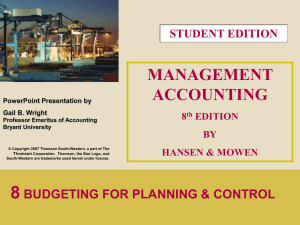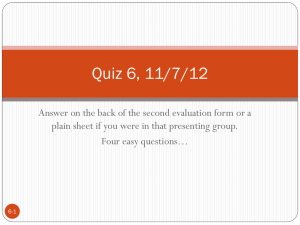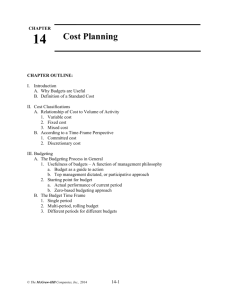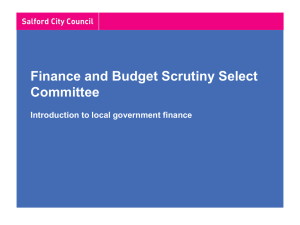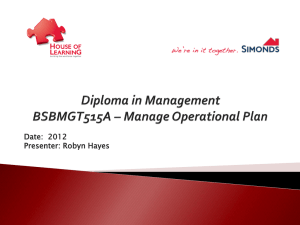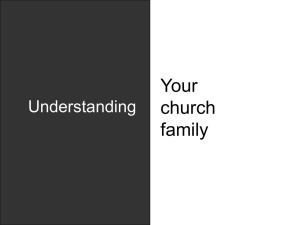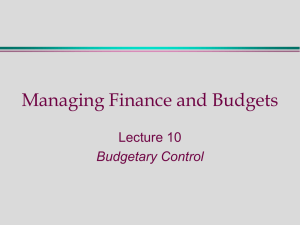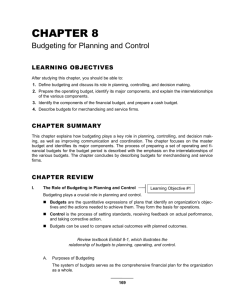Budgets
advertisement
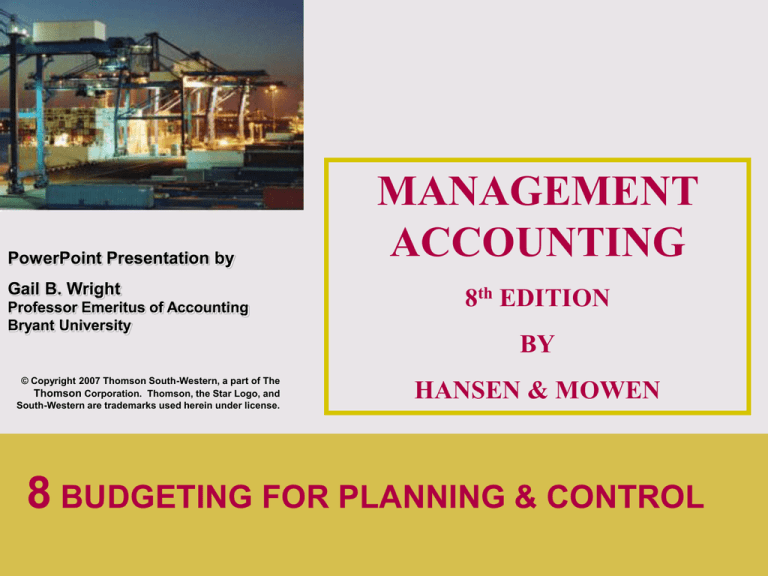
PowerPoint Presentation by Gail B. Wright Professor Emeritus of Accounting Bryant University MANAGEMENT ACCOUNTING 8th EDITION BY © Copyright 2007 Thomson South-Western, a part of The Thomson Corporation. Thomson, the Star Logo, and South-Western are trademarks used herein under license. HANSEN & MOWEN 8 BUDGETING FOR PLANNING & CONTROL 1 LEARNING OBJECTIVES LEARNING GOALS After studying this chapter, you should be able to: 2 LEARNING OBJECTIVES 1. Discuss budgeting & its role in planning, control, & decision making. 2. Define & prepare a master budget, identify its major components, & outline the interrelationships of its various components. Continued 3 LEARNING OBJECTIVES 3. Describe flexible budgeting, & list the features that a budgetary system should have to encourage managers to engage in goal-congruent behavior. 4. Explain how activity-based budgeting works. Click the button to skip Questions to Think About 4 QUESTIONS TO THINK ABOUT: Dr. Jones, DDS Why did Dr. Jones fire his bookkeeper? Were his financial problems her fault? Why or why not? 5 QUESTIONS TO THINK ABOUT: Dr. Jones, DDS How would a formal budgeting system help Dr. Jones get out of his financial difficulties? 6 QUESTIONS TO THINK ABOUT: Dr. Jones, DDS Many small businesses do not budget, reasoning that they are small enough to mentally keep track of all revenues & expenditures. Comment on this idea. 7 QUESTIONS TO THINK ABOUT: Dr. Jones, DDS Do you budget? Explain why you do or do not? 8 LEARNING OBJECTIVE 1 Discuss budgeting & its role in planning, control, & decision making. 9 LO 1 PLANNING: Definition Looking ahead to see what actions should be taken to realize particular goals. 10 LO 1 CONTROL: Definition Looking backward, determining what actually happened & comparing it with previously planned outcomes. 11 LO 1 Where do budgets fit into planning & control? Budgets are financial plans for the future, identifying objectives & the actions needed to achieve them. 12 PLANNING, CONTROL & BUDGETS LO 1 EXHIBIT 8-1 Budgets provide feedback for investigation on achieving the strategic plan. 13 LO 1 ADVANTAGES OF BUDGETING A budgetary system provides the following advantages: Forces managers to plan Provides information that can be used to improve decision making Provides a standard for performance evaluation Improves communication & coordination 14 LO 1 BUDGETS Improve decision making Set standards Compare actual to budgeted results Communicate & coordinate 15 LEARNING OBJECTIVE 2 Define & prepare a master budget. 16 LO 2 MASTER BUDGET: Definition Comprehensive financial plan for organization as a whole. 17 LO 2 What is a “continuous” budget? A continuous budget is a moving 12-month budget, adding a month as each month expires. 18 LO 2 MASTER BUDGETS: Major Components Operating budget Describes income generating activities of a firm Financial budgets Detail inflows & outflows of cash 19 LO 2 OPERATING BUDGETS: Steps in the Process 1. 2. 3. 4. 5. 6. 7. 8. Sales budget Production budget Direct materials purchases budget Direct labor budget Overhead budget Selling & administrative budget Ending finished goods inventory budget Cost of goods sold budget 20 LO 2 TEXAS REX, INC.: Background Texas Rex, Inc., is a trendy restaurant in the Southwest that sells T-shirts with a Texas Rex dinosaur logo. The operating budgets that follow are for manufacturing costs of Texas Rex T-shirts. 21 LO 2 SALES BUDGET Schedule 1 describes expected sales in units & dollars. 22 LO 2 FORMULAS: Production Units Except for JIT systems, production budgets must meet sales needs & satisfy ending inventory requirements. Units to be produced = Expected unit sales + Units in ending inventory – Units in beginning inventory 23 LO 2 PRODUCTION BUDGET Schedule 2 describes units to be produced to meet Sales Budget. 24 LO 2 TEXAS REX, INC.: Direct Materials Texas Rex, Inc., purchases 2 direct materials (DM) for production of its Texas Rex T-shirts: plain T-shirts & ink to produce the dinosaur logo. 25 LO 2 FORMULAS: Purchases Direct materials purchases budget tells amount & cost of raw materials purchased in each period. Direct materials (DM) purchased = DM needed for production + DM desired in ending inventory – DM in beginning inventory 26 LO 2 DM PURCHASES BUDGET Schedule 3 describes DM to be purchased to meet Production Budget. 27 LO 2 DIRECT LABOR BUDGET Schedule 4 shows hours & cost of DL needed to meet Production Budget. 28 LO 2 OVERHEAD BUDGET Schedule 5 shows expected indirect costs needed to meet Production Budget. 29 LO 2 How do we determine the cost of finished goods ending inventory? Unit cost of finished goods is (per unit) DM + DL + Overhead. 30 LO 2 FINISHED GOODS BUDGET Schedule 6 shows unit cost of finished goods for balance sheet. 31 LO 2 CGS BUDGET Schedule 7 presents the expected cost of goods sold for the year. 32 LO 2 How do we project income from the operating budgets? Estimate selling & administrative expenses, then transfer all information into projected income statement. 33 LO 2 SALES & ADMINISTRATIVE EXPENSES BUDGET Schedule 8 outlines planned expenditures for nonmanufacturing activities. Schedule spread over 2 pages. 34 LO 2 BUDGETED INCOME STATEMENT Schedule 9 presents a projected income statement. 35 LO 2 FINANCIAL BUDGETS 1. Cash budget 2. Budgeted balance sheet 3. Budget for capital expenditures 36 LO 2 What is the purpose of the cash budget? Cash budgets document the need for cash & the ability to repay debt. 37 LO 2 FORMULA: Cash Budget Projecting the ending cash balance includes cash collections, payments, & borrowings & includes minimum cash needed. Ending cash balance = Beginning balance + (cash receipts – disbursements) + (cash borrowing – repayments) 38 LO 2 CASH BUDGET Schedule 10 presents projected cash needs. 39 LO 2 EXHIBIT 8-5 MASTER BUDGET INTERRELATIONSHIPS 40 LO 2 BUDGETED BALANCE SHEET Schedule 11 presents end of year balance sheet. 41 LEARNING OBJECTIVE 3 Describe flexible budgeting & features that should encourage goal-congruent behavior. 42 LO 3 STATIC BUDGET: Definition A budget for a particular level of activity. 43 LO 3 Why are static budgets not good for performance evaluation? Actual level of activity may differ from the static budget level & misrepresent performance. 44 LO 3 FLEXIBLE BUDGET: Definition A budget for expected costs of a range of activity levels. 45 LO 3 How are budgets related to performance evaluation? Bonuses, salary increases, promotions are based on achieving or beating budget targets. 46 LO 3 GOAL CONGRUENCE: Definition Alignment of managerial & organizational goals. 47 LO 3 What is participative budgeting? Participative budgeting involves subordinate managers in setting budget targets to achieve goal congruence. 48 LO 3 PARTICIPATIVE BUDGETING Potential problems Setting standards either too high or too low Building slack (padding) into the budget Deliberately underestimating revenues, overestimating costs Pseudoparticipation 49 LO 3 CONTROLLABLE COSTS: Definition Are costs whose level a manager can influence 50 LEARNING OBJECTIVE 4 Explain how activitybased budgeting works. 51 LO 4 ACTIVITY-BASED BUDGETING Activity-based budgeting fits ABC & ABM systems. Budgets are developed for company activities to show the resources consumed. Can be done as a flexible budget. 52 LO 4 ACTIVITY FLEXIBLE BUDGET EXHIBIT 8-10 Budget can be developed based on different activity drivers. 53 CHAPTER 8 THE END 54
